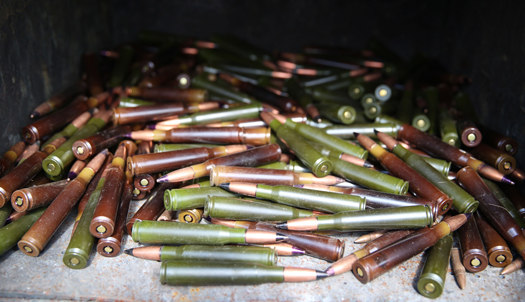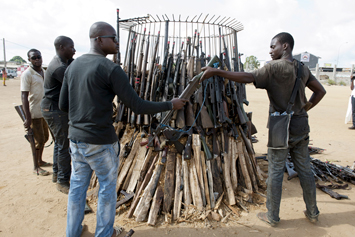Africa still cursed by glut of small arms
By Jehron Muhammad -Contributing Writer- | Last updated: Mar 14, 2017 - 1:38:38 PMWhat's your opinion on this article?

A load of small arms ammunition destroyed by the UN in Sake Democratice Republic of the Congo. The Congo was one of seven African nations named in a recent report about small arms and light weapons crisis.
|
The International Red Cross has determined small arms are the world’s principal cause of death and conflict. “Small/light arms are cheap and portable, and are used by all combatants—state militaries, militias, and insurgents.”
This widespread proliferation, combined with their indiscriminate use, has bred much of the misery on the African continent.

|
In a just released Oxfam report, “The Human Cost of Uncontrolled Arms In Africa,” the proliferation of small arms and light weapons (SALW) was defined as the main cause of prolonged conflict, proxy wars, and inter-communal strife in many parts of the continent.
Though data concerning conflict fatalities was “scarce and inconsistent,” the study found “that in the last two decades, millions of lives were lost as a direct result of wars in Africa. An example, during the period 1983-2005 in the Democratic Republic of Congo (DRC), Sudan and Rwanda combined, between 4.3 million and 8.4 million people lost their lives due to armed conflict.”
The report covered mainly seven countries—Mali, Central African Republic, South Sudan, Sudan, Democratic Republic of Congo (CAR), Somalia and Libya—and offers recommendations for arms control. It defines roles for African states, the African Union, regional economic groups, donor communities and the private sector.
Illicit weapons include revolvers, self-loading pistols, assault rifles, submachine guns, light and heavy machine guns, grenade launchers, anti-aircraft guns, anti-tank guns, and others, either purchased illegally, diverted or captured from state institutions by opposition or unauthorized groups.
Worsening economies in many African countries, the report notes, have “eroded” capacity to address “pressing developmental challenges such as poverty, unemployment and poor infrastructure.”

Light weapons destroyed at 2013 ceremony in Abidjan, Cote Dvoire. Photos: United Nations
|
When provided, job opportunities and infrastructure projects are mainly concentrated in urban centers or, in many cases, where constituencies are loyal to ruling political parties, which fuels or compounds inequality. The response from deprived or excluded groups who have grievances includes use of illicit arms against the state. “The widespread poverty and limited economic opportunities in Nigeria’s northeast region were exploited by Boka Haram to recruit and radicalize poor, uneducated and vulnerable young people,” said the report.
Another example cited was Mali’s underdeveloped northern regions relative to the South of the country. Underdevelopment was identified as a major reason the Tuaregs decided to bear weapons against the Malian state.
Then an unnamed Central African Republic representative said in the report: “The way the state has been governed in the last decade contributed to the conflict in CAR. Societies that feel abandoned have resorted to arms to express their grievances. There is a huge gap between the state and its citizens. A lot of areas occupied by Muslims have limited state presence and are marginalized. Many communities especially in the north and eastern parts of the country are not being taken care of. In the past, investments in social amenities and infrastructure are mostly concentrated in regions where presidents and other high-level state officials come from.”
Gender-based violence was of special note. This form of violence, mainly on women and girls, is widespread in conflicts. The report estimated that roughly 45.6 percent of African women have experienced gender-based violence, compared to 35 percent globally. “It estimated that most African women and girls will experience a form of GBV in their lifetime. In data derived from the UN Secretary General Special Representative on Violence in Conflict showed that between 2014 and 2015, 2,527 cases of conflict-related sexual violence were documented in CAR,” said the report.

A top UN official and head of the world body’s Mission in Mali visited the Operational Coordination Mechanism camp in Gao Northern Mali in February.
|
But statistics alone do not tell the story. One of the many incidents cited involved a 38-year-old woman. In December of 2013, in CAR, while resting at home Seleka militias broke in and raped her multiple times. She later insisted that she would have resisted if she “hadn’t been afraid that they would kill her, since they were carrying weapons.” In another incident a 27-year-old woman was accosted by two Seleka fighters after she left an Internally Displaced Person camp in search of water. The woman was physically abused and raped.
Her testimony suggests she would have resisted if the men hadn’t been carrying AK-47s.
The actual testimony of one rape victim, revealed the damaging psychological effects of gender-based violence.
“On 24 December 2015, six masked men with guns and machetes came to my house. They first asked my brother to have sex with me, but he refused. He was shot and then hacked to death for refusing. Two of the men later took a turn to rape me with guns pointed at me. My husband could not cope with the incident. He was thinking too much about it. This led to his death. I keep thinking about him. I think a lot about life.”
Tackling Africa’s proliferation of uncontrolled arms requires continent wide involvement, including African and non-African stakeholders.
While the report is a step in the right direction, its solutions not only require a successful drive at the “reduction of uncontrolled small arms and light weapons” in Africa, but also development of infrastructure and investments in social programs in historically neglected areas and areas where citizens don’t support the ruling party.
The passage of the Arms Trade Treaty (ATT) in 2013 and its implementation in 2014 are beginning steps in tackling the small arms problem. It was the first legally binding agreement which sets globally common standards for regulation of conventional arms.
But concerns remain, including the fact that 95 percent of weapons in Africa, both legal and illicit, originate from outside the continent. While the ATT in Africa might guide proper regulation and monitoring of global arms sales and transfer, who’s to say arms-exporting countries and their small armaments industries will cooperate? Legal arms import by African states increased by 45 percent between 2005 and 2009 and between 2010 and 2014.
INSIDE STORIES AND REVIEWS
-
-
About Harriett ... and the Negro Hollywood Road Show
By Rabiah Muhammad, Guest Columnist » Full Story -
Skepticism greets Jay-Z, NFL talk of inspiring change
By Bryan 18X Crawford and Richard B. Muhammad The Final Call Newspaper @TheFinalCall » Full Story -
The painful problem of Black girls and suicide
By Charlene Muhammad -National Correspondent- » Full Story -
Exploitation of Innocence - Report: Perceptions, policies hurting Black girls
By Charlene Muhammad -National Correspondent- » Full Story -
Big Ballin: Big ideas fuel a father’s Big Baller Brand and brash business sense
By Bryan Crawford -Contributing Writer- » Full Story






 Click Here Stay Connected!
Click Here Stay Connected!








